Supply–Demand Evaluation of Green Stormwater Infrastructure (GSI) Based on the Model of Coupling Coordination
Abstract
1. Introduction
2. Materials and Methods
2.1. Case Study
2.2. Data Sourcing and Processing
2.3. Analysis of the Relationship between GSI Supply and Demand
3. Results
3.1. GSI Supply and Demand Levels
3.2. Coupling and Coordination Degrees of GSI Supply and Demand
4. Discussion
4.1. Contributions of Supply–Demand Structural Analysis to Flooding Management
4.2. Causes of Supply–Demand Imbalances and Improvement Measures
4.3. Limitations and Future Research Prospects
5. Conclusions
Author Contributions
Funding
Institutional Review Board Statement
Informed Consent Statement
Data Availability Statement
Conflicts of Interest
References
- Zhang, B.; Xie, G.-D.; Li, N.; Wang, S. Effect of urban green space changes onthe role of rainwater runoff reduction in Beijing, China. Landsc. Urban Plan. 2015, 140, 8–16. [Google Scholar] [CrossRef]
- Wang, H.; Zhou, J.; Tang, Y.; Liu, Z.; Kang, A.; Chen, B. Flood economic assessment of structural measure based on integrated flood risk management: A case study in Beijing. J. Environ. Manag. 2021, 280, 111701. [Google Scholar] [CrossRef] [PubMed]
- Hu, M.; Zhang, X.; Siu, Y.L.; Li, Y.; Tanaka, K.; Yang, H.; Xu, Y. Flood mitigation by permeable pavements in Chinese sponge city construction. Water 2018, 10, 172. [Google Scholar] [CrossRef]
- Sofia, G.; Ragazzi, F.; Giandon, P.; Dalla Fontana, G.; Tarolli, P. On the linkage between runoff generation, land drainage, soil properties, and temporal patterns of precipitation in agricultural floodplains. Adv. Water Resour. 2019, 124, 120–138. [Google Scholar] [CrossRef]
- Echols, S. Split-flow theory: Stormwater design to emulate natural landscapes. Landsc. Urban Plan. 2008, 85, 205–214. [Google Scholar] [CrossRef]
- Wang, M.; Zhang, Y.; Bakhshipour, A.E.; Liu, M.; Rao, Q.; Lu, Z. Designing coupled LID–GREI urban drainage systems: Resilience assessment and decision-making framework. Sci. Total Environ. 2022, 834, 15526. [Google Scholar] [CrossRef]
- Wu, Z.; Li, Z.; Zeng, H. Using remote sensing data to study the coupling relationship between urbanization and eco-environment change: A case study in the Guangdong-Hong Kong-Macao greater bay area. Sustainability 2020, 12, 7875. [Google Scholar] [CrossRef]
- Liu, H.; Jia, Y.; Niu, C. “Sponge city” concept helps solve China’s urban water problems. Environ. Earth Sci. 2017, 76, 473–479. [Google Scholar] [CrossRef]
- Wang, Z.Q.; Wang, H.M.; Huang, J.; Kang, J.L.; Han, D.W. Analysis of the Public Flood Risk Perception in a Flood-Prone City: The Case of Jingdezhen City in China. Water 2018, 10, 1577. [Google Scholar] [CrossRef]
- Moore, S. The political economy of flood management reform in China. Int. J. Water Resour. Dev. 2018, 34, 566–577. [Google Scholar] [CrossRef]
- Lyu, H.M.; Shen, S.L.; Zhou, A.N.; Zhou, W.H. Flood risk assessment of metro systems in a subsiding environment using the interval FAHP-FCA approach. Sustain. Cities Soc. 2019, 50, 101682. [Google Scholar] [CrossRef]
- Liu, Y.; Li, T.; Yu, L. Urban heat island mitigation and hydrology performance of innovative permeable pavement: A pilot-scale study. J. Clean. Prod. 2020, 244, 118938. [Google Scholar] [CrossRef]
- Lu, G.; Wang, L. An Integrated Framework of Green Stormwater Infrastructure Planning—A Review. Sustainability 2021, 13, 13942. [Google Scholar] [CrossRef]
- Knight, K.L.; Hou, G.; Bhaskar, A.S.; Chen, S. Assessing the Use of Dual-Drainage Modeling to Determine the Effects of Green Stormwater Infrastructure on Roadway Flooding and Traffic Performance. Water 2021, 13, 1563. [Google Scholar] [CrossRef]
- Ureta, J.; Motallebi, M.; Scaroni, A.E.; Lovelace, S.; Ureta, J.C. Understanding the public’s behavior in adopting green stormwater infrastructure. Sustain. Cities Soc. 2021, 69, 102815. [Google Scholar] [CrossRef]
- Shafique, M.; Kim, R. Green stormwater infrastructure with low impact development concept: A review of current research. Desalin. Water Treat. 2017, 83, 16–29. [Google Scholar] [CrossRef]
- Guan, X.; Wang, J.; Xiao, F. Sponge city strategy and application of pavement materials in sponge city. J. Clean. Prod. 2021, 303, 127022. [Google Scholar] [CrossRef]
- Kumar, N.; Liu, X.; Narayanasamydamodaran, S.; Pandey, K.K. A systematic review comparing urban flood management practices in India to China’s sponge city program. Sustainability 2021, 13, 6346. [Google Scholar] [CrossRef]
- Zhou, S.; Liu, Z.; Wang, M.; Gan, W.; Zhao, Z.; Wu, Z. Impacts of building configurations on urban stormwater management at a block scale using XGBoost. Sustain. Cities Soc. 2022, 87, 104235. [Google Scholar] [CrossRef]
- Ministry of Housing and Urban-Rural Development. Technical Guidance for Sponge City: Constructing Low Impact Development Rainwater System (MHURD, 2014–2275). 2014. Available online: https://www.mohurd.gov.cn/gongkai/fdzdgknr/zfhcxjsbwj/201411/20141103_219465.html (accessed on 16 September 2016). (In Chinese)
- Ministry of Finance of the People’s Republic of China. The Results of the 2021 Demonstration Evaluation on the Systematic and Comprehensive Promotion of Sponge City Construction (MFPRC, 2021–2035). 2021. Available online: http://jjs.mof.gov.cn/tongzhigonggao/202105/t20210512_3700579.htm (accessed on 2 June 2021). (In Chinese)
- Conley, G.; Beck, N.; Riihimaki, C.; McDonald, K.; Tanner, M. Assessing the Feasibility of a Cloud-Based, Spatially Distributed Modeling Approach for Tracking Green Stormwater Infrastructure Runoff Reductions. Water 2021, 13, 255. [Google Scholar] [CrossRef]
- Zhang, Q.; Wu, Z.; Tarolli, P. Investigating the Role of Green Infrastructure on Urban WaterLogging: Evidence from Metropolitan Coastal Cities. Remote Sens. 2021, 13, 2341. [Google Scholar] [CrossRef]
- Yang, Y.; Li, J.; Huang, Q.; Xia, J.; Li, J.; Liu, D.; Tan, Q. Performance assessment of sponge city infrastructure on stormwater outflows using isochrone and SWMM models. J. Hydrol. 2021, 597, 126151. [Google Scholar] [CrossRef]
- Gong, Y.; Fu, H.; Li, H.; Chen, Y.; Zhang, W.; Wu, L.; Li, Y. Influences of time scale on green stormwater infrastructure’s effect on suspended solids in urban rainfall runoff. J. Hydrol. 2021, 598, 126439. [Google Scholar] [CrossRef]
- Gong, C.; Xian, C.; Cui, B.; He, G.; Wei, M.; Zhang, Z.; Ouyang, Z. Estimating NOx removal capacity of urban trees using stable isotope method: A case study of Beijing, China. Environ. Pollut. 2021, 290, 118004. [Google Scholar] [CrossRef]
- Jessup, K.; Parker, S.S.; Randall, J.M.; Cohen, B.S.; Roderick-Jones, R.; Ganguly, S.; Sourial, J. Planting Stormwater Solutions: A methodology for siting nature-based solutions for pollution capture, habitat enhancement, and multiple health benefits. Urban For. Urban Green. 2021, 64, 127300. [Google Scholar] [CrossRef]
- Wang, W.; Wu, T.; Li, Y.; Zheng, H.; Ouyang, Z. Matching ecosystem services supply and demand through land use optimization: A study of the Guangdong-Hong KongMacao megacity. Int. J. Environ. Res. Public Health. 2021, 18, 2324. [Google Scholar] [CrossRef]
- Li, B.; Dong, S.L.; Huang, Y.F.; Wang, G.Q. Development of a heterogeneity analysis framework for collaborative sponge city management. Water 2019, 11, 1995. [Google Scholar] [CrossRef]
- Zhang, Y.; Xia, J.; Yu, J.; Randall, M.; Zhang, Y.; Zhao, T.; Pan, X.; Zhai, X.; Shao, Q. Simulation and assessment of urbanization impacts on runoff metrics: Insightsfrom landuse changes. J. Hydrol. 2018, 560, 247.e258. [Google Scholar] [CrossRef]
- Zhu, Z.; Lang, W.; Tao, X.; Feng, J.; Liu, K. Exploring the quality of urban green spaces based on urban Neighborhood Green Index—A case study of Guangzhou City. Sustainability 2019, 11, 5507. [Google Scholar] [CrossRef]
- BenDor, T.K.; Shandas, V.; Miles, B.; Belt, K.; Olander, L. Ecosystem services and US stormwater planning: An approach for improving urban stormwater decisions. Environ. Sci. Policy 2018, 88, 92–103. [Google Scholar] [CrossRef]
- Cao, X.; Ni, G.; Qi, Y.; Liu, B. Does subgrid routing information matter for urban flood forecasting? A multiscenario analysis at the land parcel scale. J. Hydrometeorol. 2020, 21, 2083–2099. [Google Scholar] [CrossRef]
- Maragno, D.; Gaglio, M.; Robbi, M.; Appiotti, F.; Fano, E.A.; Gissi, E. Fine-scale analysis of urban flooding reduction from green infrastructure: An ecosystem services approach for the management of water flows. Ecol. Model. 2018, 386, 1–10. [Google Scholar] [CrossRef]
- de Manuel, B.F.; Méndez-Fernández, L.; Peña, L.; Ametzaga-Arregi, I. A new indicator of the effectiveness of urban green infrastructure based on ecosystem services assessment. Basic Appl. Ecol. 2021, 53, 12–25. [Google Scholar] [CrossRef]
- Herreros-Cantis, P.; McPhearson, T. Mapping supply and demand for ecosystem services to assess environmental justice in New York City. Ecol. Appl. 2021, 31, e02390. [Google Scholar] [CrossRef]
- Fňukalová, E.; Zýka, V.; Romportl, D. The network of green infrastructure based on ecosystem services supply in Central Europe. Land 2021, 10, 592. [Google Scholar] [CrossRef]
- Li, C.; Liu, M.; Hu, Y.; Zhou, R.; Wu, W.; Huang, N. Evaluating the runoff storage supply-demand structure of green infrastructure for urban flood management. J. Clean. Prod. 2021, 280, 124420. [Google Scholar] [CrossRef]
- Mei, C.; Liu, J.; Wang, H.; Yang, Z.; Ding, X.; Shao, W. Integrated assessments of green infrastructure for flood mitigation to support robust decision-making for sponge city construction in an urbanized watershed. Sci. Total Environ. 2018, 639, 1394–1407. [Google Scholar] [CrossRef] [PubMed]
- Joyce, J.; Chang, N.B.; Harji, R.; Ruppert, T.; Imen, S. Developing a multi-scale modeling system for resilience assessment of green-grey drainage infrastructures under climate change and sea level rise impact. Environ. Modell Softw. 2017, 90, 1–26. [Google Scholar] [CrossRef]
- Zhang, S.; Pan, B. An urban storm-inundation simulation method based on GIS. J. Hydrol. 2014, 517, 260–268. [Google Scholar] [CrossRef]
- Chen, A.S.; Evans, B.; Djordjević, S.; Savić, D.A. Multi-layered coarse grid modelling in 2D urban flood simulations. J. Hydrol. 2012, 470, 1–11. [Google Scholar] [CrossRef]
- Lei, X.; Chen, W.; Panahi, M.; Falah, F.; Rahmati, O.; Uuemaa, E.; Kalantari, Z.; Ferreira, C.S.S.; Rezaie, F.; Bian, H. Urban flood modeling using deep-learning approaches in Seoul, South Korea. J. Hydrol. 2021, 601, 126684. [Google Scholar] [CrossRef]
- Meerow, S.; Newell, J.P. Spatial planning for multifunctional green infrastructure: Growing resilience in Detroit. Landscape Urban Plan. 2017, 159, 62–75. [Google Scholar] [CrossRef]
- Ramyar, R.; Saeedi, S.; Bryant, M.; Davatgar, A.; Hedjri, G.M. Ecosystem services mapping for green infrastructure planning–The case of Tehran. Sci. Total Environ. 2020, 703, 135466. [Google Scholar] [CrossRef]
- Heckert, M.; Rosan, C.D. Developing a green infrastructure equity index to promote equity planning. Urban For. Urban Gree. 2016, 19, 263–270. [Google Scholar] [CrossRef]
- Qi, Y.; Farnoosh, A.; Lin, L.; Liu, H. Coupling coordination analysis of China’s provincial water-energy-food nexus. Environ. Sci. Pollut. Res. 2022, 29, 23303–23313. [Google Scholar] [CrossRef] [PubMed]
- Sun, C.; Zhang, S.; Song, C.; Xu, J.; Fan, F. Investigation of dynamic coupling coordination between urbanization and the eco-environment—a case study in the Pearl river delta area. Land 2021, 10, 190. [Google Scholar] [CrossRef]
- Xiao, R.; Yu, X.; Xiang, T.; Zhang, Z.; Wang, X.; Wu, J. Exploring the coordination between physical space expansion and social space growth of China’s urban agglomerations based on hierarchical analysis. Land Use Policy 2021, 109, 105700. [Google Scholar] [CrossRef]
- Sun, Y.; Liu, S.; Dong, Y.; An, Y.; Shi, F.; Dong, S.; Liu, G. Spatio-temporal evolution scenarios and the coupling analysis of ecosystem services with land use change in China. Sci. Total Environ. 2019, 681, 211–225. [Google Scholar] [CrossRef] [PubMed]
- Sun, Y.; Liu, D.; Wang, P. Urban simulation incorporating coordination relationships of multiple ecosystem services. Sustain. Cities Soc. 2022, 76, 103432. [Google Scholar] [CrossRef]
- Zhai, T.; Wang, J.; Fang, Y.; Huang, L.; Liu, J.; Zhao, C. Integrating ecosystem services supply, demand and flow in ecological compensation: A case study of carbon sequestration services. Sustainability 2021, 13, 1668. [Google Scholar] [CrossRef]
- Liu, N.; Liu, C.; Xia, Y.; Da, B. Examining the coordination between urbanization and eco-environment using coupling and spatial analyses: A case study in China. Ecol. Indicat. 2018, 93, 1163–1175. [Google Scholar] [CrossRef]
- Li, J.; Yuan, W.; Qin, X.; Qi, X.; Meng, L. Coupling coordination degree for urban green growth between public demand and government supply in urban agglomeration: A case study from China. J. Environ. Manag. 2022, 304, 114209. [Google Scholar] [CrossRef] [PubMed]
- Zhang, Q.; Wu, Z.; Zhang, H.; Dalla Fontana, G.; Tarolli, P. Identifying dominant factors of waterlogging events in metropolitan coastal cities: The case study of Guangzhou, China. J. Environ. Manag. 2020, 271, 110951. [Google Scholar] [CrossRef] [PubMed]
- Dąbrowski, M.; Stead, D.; He, J.; Yu, F. Adaptive capacity of the Pearl River Delta cities in the face of the growing flood risk: Institutions, ideas and interests. Urban Stud. 2021, 58, 2683–2702. [Google Scholar] [CrossRef]
- Zhu, Z.; Ren, J.; Liu, X. Green infrastructure provision for environmental justice: Application of the equity index in Guangzhou, China. Urban Fore.Urban Gree. 2019, 46, 126443. [Google Scholar] [CrossRef]
- Ministry of Housing and Urban-Rural Development. National Standards for Garden Cities (MHURD, 2016). 2016. Available online: https://www.mohurd.gov.cn/gongkai/fdzdgknr/tzgg/201611/20161104_229393.html (accessed on 28 April 2017). (In Chinese)
- Wang, K.; Zhang, L.; Zhang, L.; Cheng, S. Coupling coordination assessment on sponge city construction and its spatial pattern in Henan province, China. Water 2020, 12, 3482. [Google Scholar] [CrossRef]
- He, S.; Lin, L.; Xu, Q.; Hu, C.; Zhou, M.; Liu, J.; Li, Y.; Wang, K. Farmland Zoning Integrating Agricultural Multi-Functional Supply, Demand and Relationships: A Case Study of the Hangzhou Metropolitan Area, China. Land 2021, 10, 1014. [Google Scholar] [CrossRef]
- Wang, R.; Tan, J. Exploring the coupling and forecasting of financial development, technological innovation, and economic growth. Technol. Forecast. Soc. 2021, 163, 120466. [Google Scholar] [CrossRef]
- Chang, H.S.; Lin, Z.H.; Hsu, Y.Y. Planning for green infrastructure and mapping synergies and trade-offs: A case study in the Yanshuei River Basin, Taiwan. Urban For. Urban Gree. 2021, 65, 127325. [Google Scholar] [CrossRef]
- Wang, M.; Zhang, Y.; Zhang, D.; Zheng, Y.; Li, S.; Tan, S.K. Life-cycle cost analysis and resilience consideration for coupled grey infrastructure and low-impact development practices. Sustain. Cities Soc. 2021, 75, 103358. [Google Scholar] [CrossRef]
- Lin, J.; He, P.; Yang, L.; He, X.; Lu, S.; Liu, D. Predicting future urban waterlogging-prone areas by coupling the maximum entropy and FLUS model. Sustain. Cities Soc. 2022, 80, 103812. [Google Scholar] [CrossRef]
- Lv, H.; Guan, X.; Meng, Y. Comprehensive evaluation of urban flood-bearing risks based on combined compound fuzzy matter-element and entropy weight model. Nat. Hazards 2020, 103, 1823–1841. [Google Scholar] [CrossRef]
- Xin, R.; Skov-Petersen, H.; Zeng, J.; Zhou, J.; Li, K.; Hu, J.; Liu, X.; Kong, J.; Wang, Q. Identifying key areas of imbalanced supply and demand of ecosystem services at the urban agglomeration scale: A case study of the Fujian Delta in China. Sci. Total Environ. 2021, 791, 148173. [Google Scholar] [CrossRef] [PubMed]
- Tao, Y.; Wang, H.; Ou, W.; Guo, J. A land-cover-based approach to assessing ecosystem services supply and demand dynamics in the rapidly urbanizing Yangtze River Delta region. Land Use Policy 2018, 72, 250–258. [Google Scholar] [CrossRef]
- Wang, D.; Hu, Y.; Tang, P.; Liu, C.; Kong, W.; Jiao, J.; Liu, Y. Identification of Priority Implementation Areas and Configuration Types for Green Infrastructure Based on Ecosystem Service Demands in Metropolitan City. Int. J. Environ. Res. Pub. Health 2022, 19, 8191. [Google Scholar] [CrossRef]
- Liang, X.; Tian, H.; Li, X.; Huang, J.L.; Clarke, K.C.; Yao, Y.; Guan, Q.; Hu, G. Modeling the dynamics and walking accessibility of urban open spaces under various policy scenarios. Landscape Urban Plan. 2021, 207, 103993. [Google Scholar] [CrossRef]
- Cortinovis, C.; Geneletti, D. Ecosystem services in urban plans: What is there, and what is still needed for better decisions. Land Use Policy 2018, 70, 298–312. [Google Scholar] [CrossRef]
- Shen, J.; Du, S.; Huang, Q.; Yin, J.; Zhang, M.; Wen, J.; Gao, J. Mapping the city-scale supply and demand of ecosystem flood regulation services—A case study in Shanghai. Ecol. Indic. 2019, 106, 105544. [Google Scholar] [CrossRef]
- Aerts, J. A Review of Cost Estimates for Flood Adaptation. Water 2018, 10, 1646. [Google Scholar] [CrossRef]
- Jongman, B. Effective adaptation to rising flood risk. Nat. Commun. 2018, 9, 1986. [Google Scholar] [CrossRef]
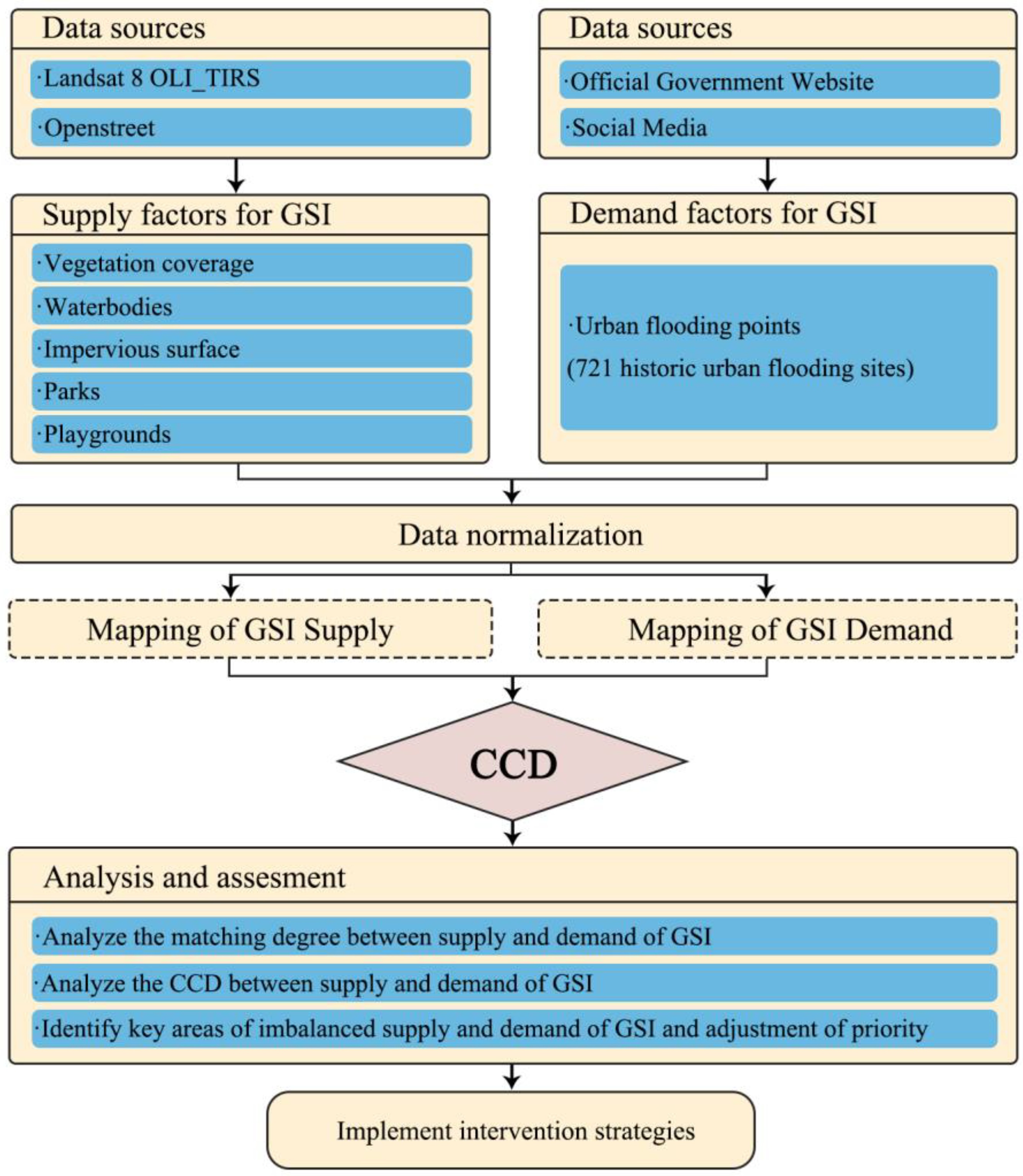

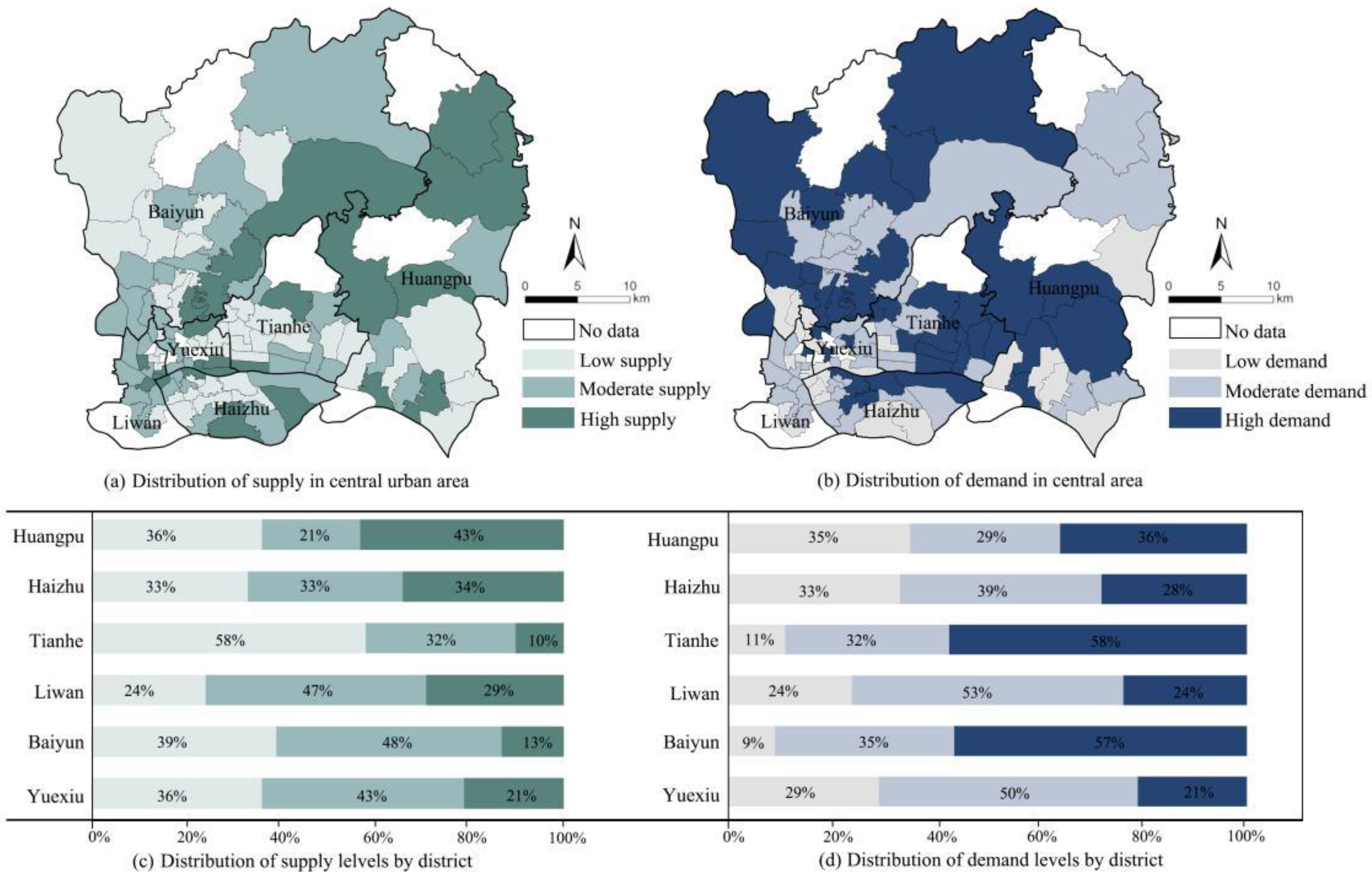
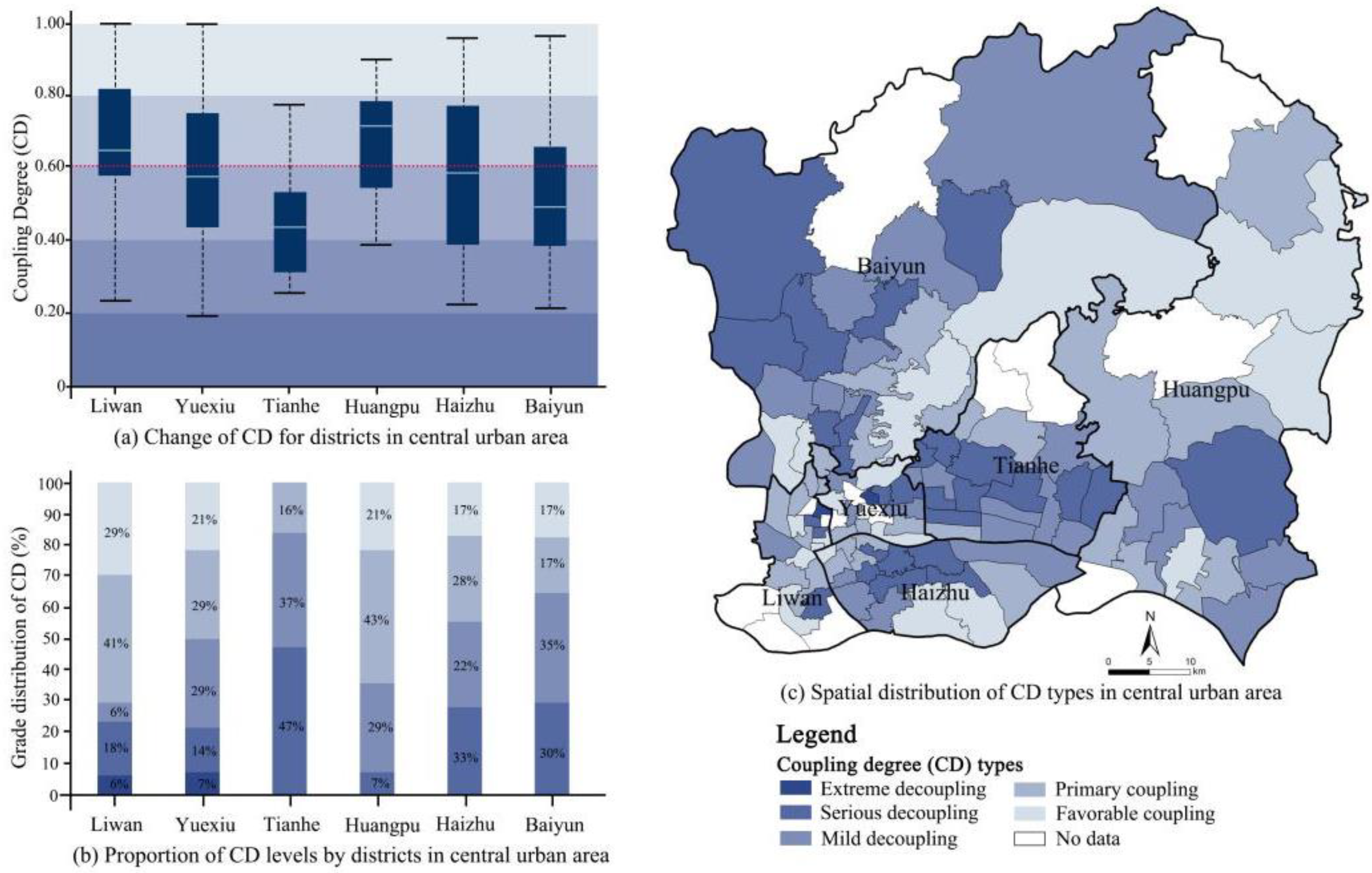
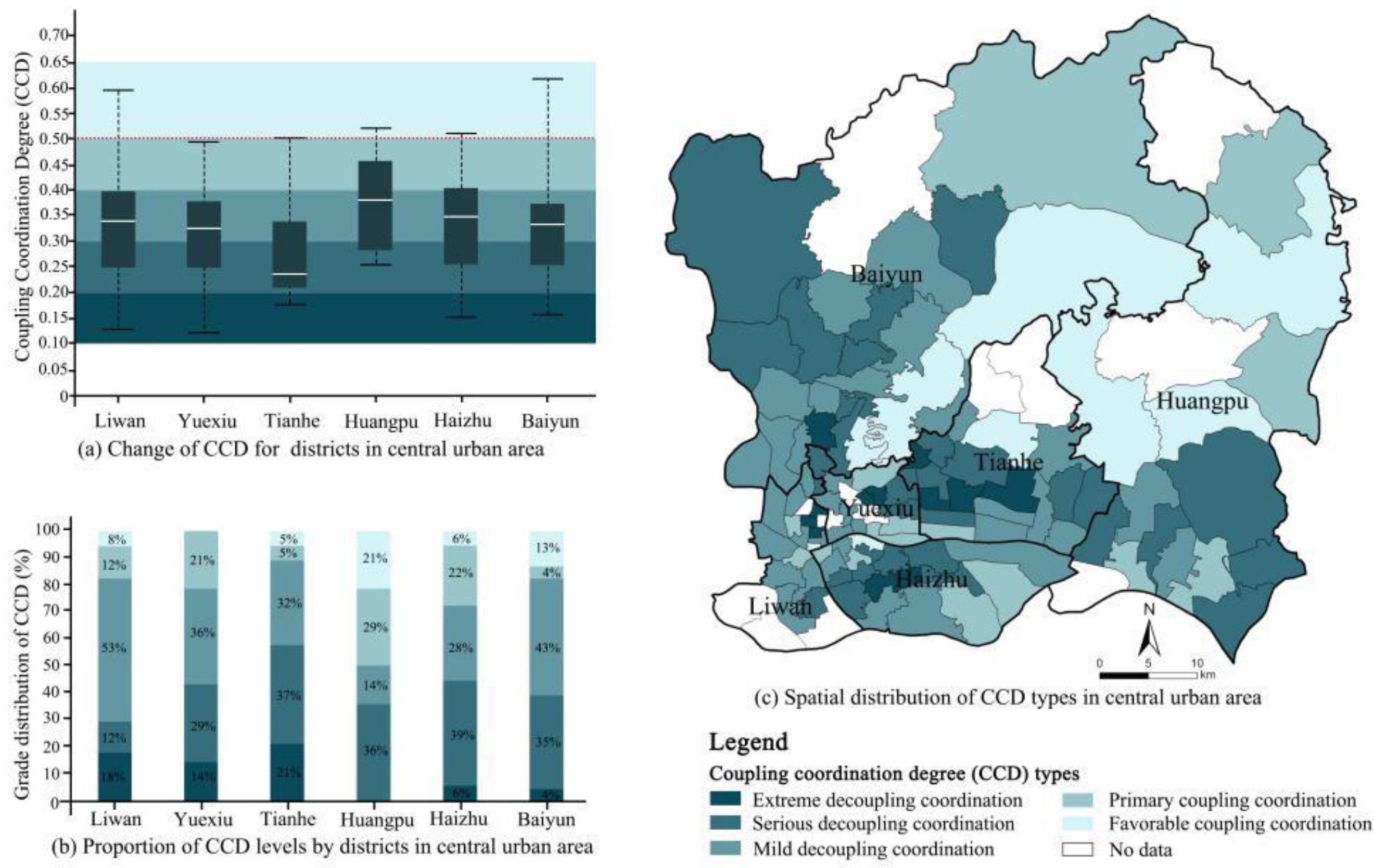
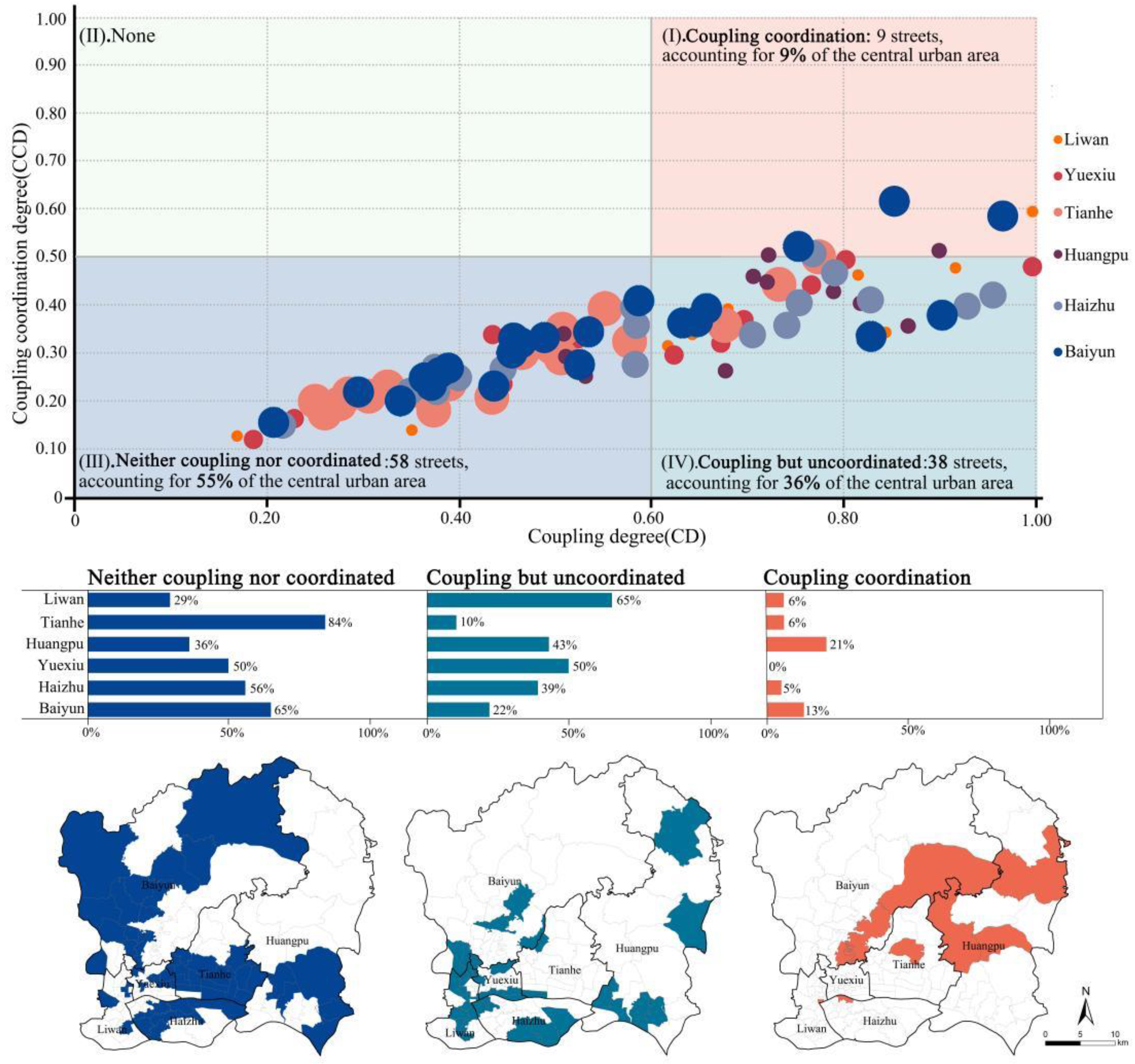
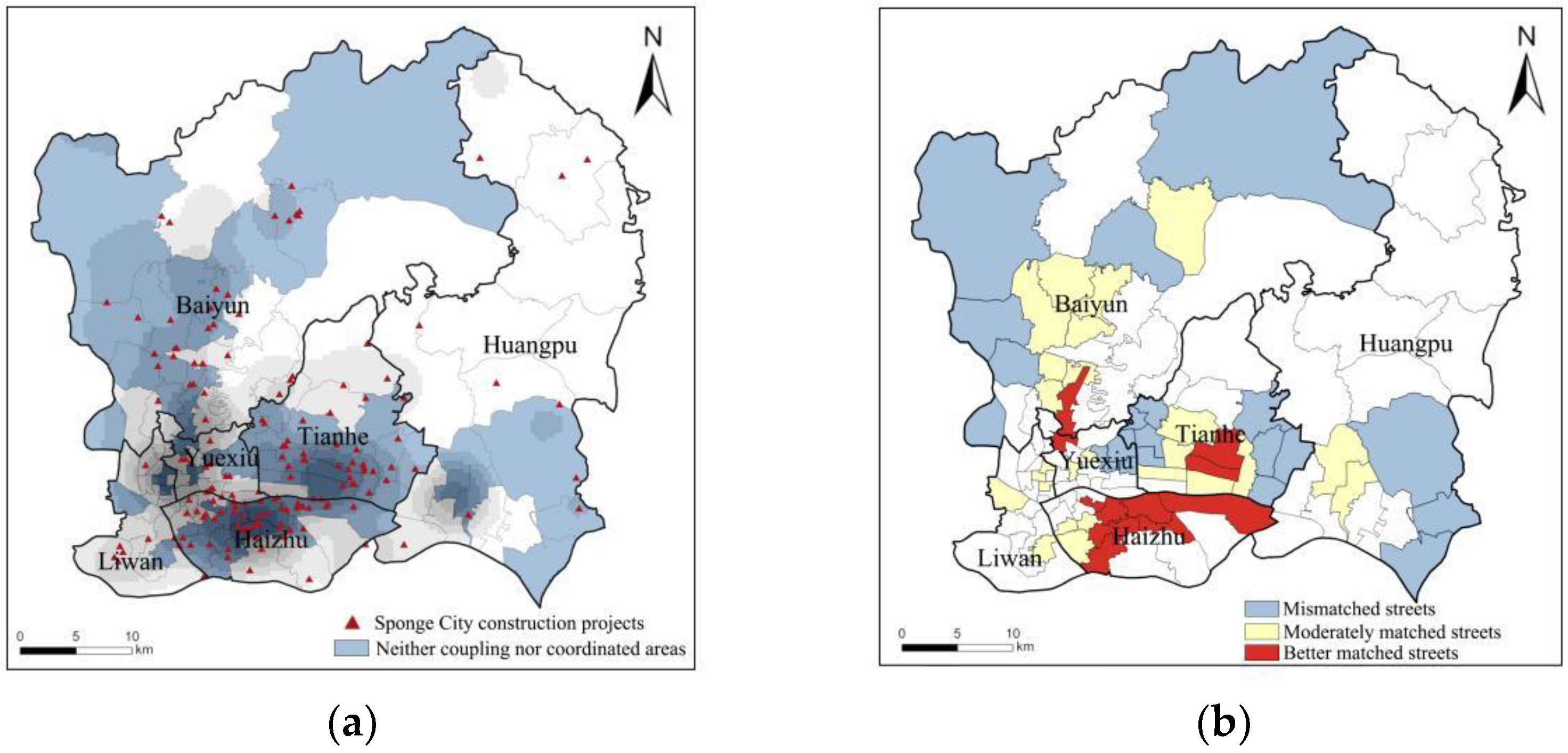
| Systems | Subsystems | Format | Expected Impact | Data Sources |
|---|---|---|---|---|
| The demand of the GSI | Urban flooding points | Shapefile | Positive | Water Resources Department of Guangdong Province, China (http://swj.gz.gov.cn/, accessed on 15 December 2021) TouTiao (https://www.toutiao.com, accessed on 6 January 2022) |
| The supply of the GSI | Vegetation coverag | Shapefile | Positive | OpenStreetMap (https://www.openhistoricalmap.org/, accessed on 19 December 2021) |
| Waterbodies | Shapefile | Positive | OpenStreetMap (https://www.openhistoricalmap.org/, accessed on 19 December 2021) | |
| Parks | Shapefile | Positive | OpenStreetMap (https://www.openhistoricalmap.org/, accessed on 19 December 2021) | |
| Playgrounds | Shapefile | Positive | OpenStreetMap (https://www.openhistoricalmap.org/, accessed on 19 December 2021) | |
| Impervious surface | Shapefile | Negetive | Landsat 8 Operational Land Imager_Thermal Infrared Sensor |
| Coupling Index Value | Coupling Types | Coupling Index Value | Coupling Coordination Types |
|---|---|---|---|
| 0~0.200 | Extreme decoupling | 0~0.200 | Extreme decoupling coordination |
| 0.200~0.400 | Serious decoupling | 0.200~0.300 | Serious decoupling coordination |
| 0.400~0.600 | Mild decoupling | 0.300~0.400 | Mild decoupling coordination |
| 0.600~0.800 | Primary coupling | 0.400~0.500 | Primary coupling coordination |
| 0.800~1.000 | Favorable coupling | 0.500~0.700 | Favorable coupling coordination |
| District | Demand Value | Supply Value | D-Value |
|---|---|---|---|
| Haizhu | 0.725 | 0.264 | 0.461 |
| Tianhe | 0.804 | 0.221 | 0.583 |
| Liwan | 0.658 | 0.271 | 0.387 |
| Yuexiu | 0.716 | 0.259 | 0.457 |
| Baiyun | 0.794 | 0.266 | 0.528 |
| Huangpu | 0.722 | 0.301 | 0.421 |
| Mean | 0.737 | 0.264 | 0.473 |
Publisher’s Note: MDPI stays neutral with regard to jurisdictional claims in published maps and institutional affiliations. |
© 2022 by the authors. Licensee MDPI, Basel, Switzerland. This article is an open access article distributed under the terms and conditions of the Creative Commons Attribution (CC BY) license (https://creativecommons.org/licenses/by/4.0/).
Share and Cite
Wang, M.; Chen, F.; Zhang, D.; Rao, Q.; Li, J.; Tan, S.K. Supply–Demand Evaluation of Green Stormwater Infrastructure (GSI) Based on the Model of Coupling Coordination. Int. J. Environ. Res. Public Health 2022, 19, 14742. https://doi.org/10.3390/ijerph192214742
Wang M, Chen F, Zhang D, Rao Q, Li J, Tan SK. Supply–Demand Evaluation of Green Stormwater Infrastructure (GSI) Based on the Model of Coupling Coordination. International Journal of Environmental Research and Public Health. 2022; 19(22):14742. https://doi.org/10.3390/ijerph192214742
Chicago/Turabian StyleWang, Mo, Furong Chen, Dongqing Zhang, Qiuyi Rao, Jianjun Li, and Soon Keat Tan. 2022. "Supply–Demand Evaluation of Green Stormwater Infrastructure (GSI) Based on the Model of Coupling Coordination" International Journal of Environmental Research and Public Health 19, no. 22: 14742. https://doi.org/10.3390/ijerph192214742
APA StyleWang, M., Chen, F., Zhang, D., Rao, Q., Li, J., & Tan, S. K. (2022). Supply–Demand Evaluation of Green Stormwater Infrastructure (GSI) Based on the Model of Coupling Coordination. International Journal of Environmental Research and Public Health, 19(22), 14742. https://doi.org/10.3390/ijerph192214742







